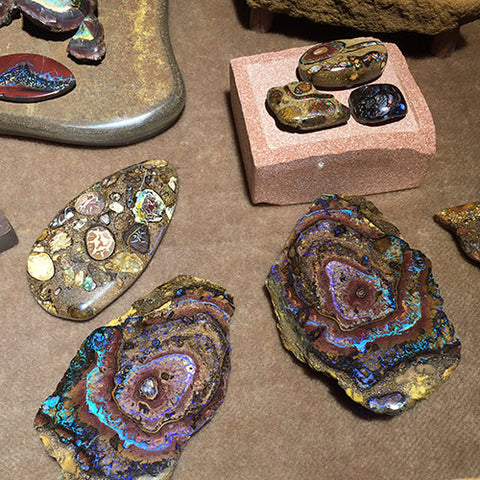We have just returned from an absolutely fabulous trip to the land of opals and kangaroos! We had the opportunity to visit several opal mines, as well as one of the largest Australian sapphire mines; this will be the subject of our next newsletter. We had the opportunity to meet and chat with extraordinary miners who were generous enough to show us their mines and the opal mining process from A to Z. Most of the mines are on private land whose owners rent out the concessions to miners. These extremely arid lands are mainly used for livestock.
All the miners we have met have proven to us that their work is based on patience, determination, and certainly also a little dose of madness!
The formation of opals
Opals need extremely special conditions as well as millions of years to form. Here is a very brief and simplified overview of the formation of opals; a process that began in the water of rivers that flowed when dinosaurs still lived on Earth.
The water from these rivers, already rich in silica, flows over sandstone beds. With gravity, the water and silica solution settles into cavities as a gel and slowly the water evaporates. The silica that remains, in the form of miniature spherules (about 150 to 700 nanometers in diameter), is then trapped in the cavities. This is why we often find opals in the shape of nodules or horizontal "veins" corresponding to ancient riverbeds or inland seas.
If the molecules form in regular spheres and in ordered rows, the light diffracts and then produces the play of color. If they are simply deposited without being ordered, there is formation of common opal, or potch, which she does not have any color play. Larger (much rarer) spherules produce red colored flashes while smaller spherules produce purple and blue.
An overview of the different types of opals
The world of opals is absolutely fabulous. There is a wide variety of opals all over the world, but it is those from Australia that are the best known and most often used in jewelry.
White opals
White opals are the most common of the precious opals (with color schemes). They are located southwest of Brisbane. The base of the opal varies from white to very light gray.
|
|
Black opals (and darkopals)
Black Opals are found exclusively at Lightning Ridge in New South Wales, Australia. This is the town where most of the mines are located, but black opals can be found all along the ridge of the same name which is about 100 km long. The color plays of black opals are particularly pronounced because of the black background and the contrast with the colored flashes. They are the most expensive opals in the world, but also the rarest!
|
|
|
| |
Boulder Opals
Boulder opals are found in ironstone. The valuable material is often in veins or in layers too thin to be extracted from the bedrock. Unlike black and white opals, the stone of which is made entirely of opal, Boulder opal is cut from the host rock. It is often larger and less expensive than black opal, although its color play is absolutely dramatic given its relatively dark background.
|
|
Matrix Opals
Matrix opals are found as small veins in ironstone. This is the same type of formation as Boulder opal, but the veins are finer (they are actually cracks filled with silica turned opal).
|
|

|
| |
Opalized fossils
Since opal is a material that forms in porous media, it can be found in fossils of bones, shells, or fossilized wood.
|
|









